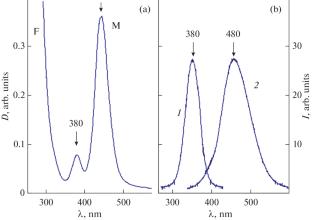氟化钠和氟化锂短波范围的新色彩中心
IF 0.48
Q4 Physics and Astronomy
Bulletin of the Russian Academy of Sciences: Physics
Pub Date : 2024-08-19
DOI:10.1134/S1062873824707050
引用次数: 0
摘要
摘要 作者研究了短波(400-500 nm)范围内 LiF 晶体内部发光中心的形成机制。研究发现,所研究的发光中心是由辐射热过程产生的本征晶格缺陷。提出的中心模型是在 NaF 晶格中获得的。研究证实,氟化钠中的新中心可以在黄绿范围内获得短波发光。本文章由计算机程序翻译,如有差异,请以英文原文为准。


New Color Centers of the Short-Wave Range in Sodium and Lithium Fluorides
The authors investigate the mechanism behind the formation of luminescence centers inside LiF crystals in the short-wave range (400–500 nm). The studied centers are found to be intrinsic crystal lattice defects, created by a radiation–thermal process. The proposed center model is obtained in the NaF lattice. It is established that new centers in sodium fluoride allow short-wave luminescence to be obtained in the yellow-green range.
求助全文
通过发布文献求助,成功后即可免费获取论文全文。
去求助
来源期刊

Bulletin of the Russian Academy of Sciences: Physics
Physics and Astronomy-Physics and Astronomy (all)
CiteScore
0.90
自引率
0.00%
发文量
251
期刊介绍:
Bulletin of the Russian Academy of Sciences: Physics is an international peer reviewed journal published with the participation of the Russian Academy of Sciences. It presents full-text articles (regular, letters to the editor, reviews) with the most recent results in miscellaneous fields of physics and astronomy: nuclear physics, cosmic rays, condensed matter physics, plasma physics, optics and photonics, nanotechnologies, solar and astrophysics, physical applications in material sciences, life sciences, etc. Bulletin of the Russian Academy of Sciences: Physics focuses on the most relevant multidisciplinary topics in natural sciences, both fundamental and applied. Manuscripts can be submitted in Russian and English languages and are subject to peer review. Accepted articles are usually combined in thematic issues on certain topics according to the journal editorial policy. Authors featured in the journal represent renowned scientific laboratories and institutes from different countries, including large international collaborations. There are globally recognized researchers among the authors: Nobel laureates and recipients of other awards, and members of national academies of sciences and international scientific societies.
 求助内容:
求助内容: 应助结果提醒方式:
应助结果提醒方式:


